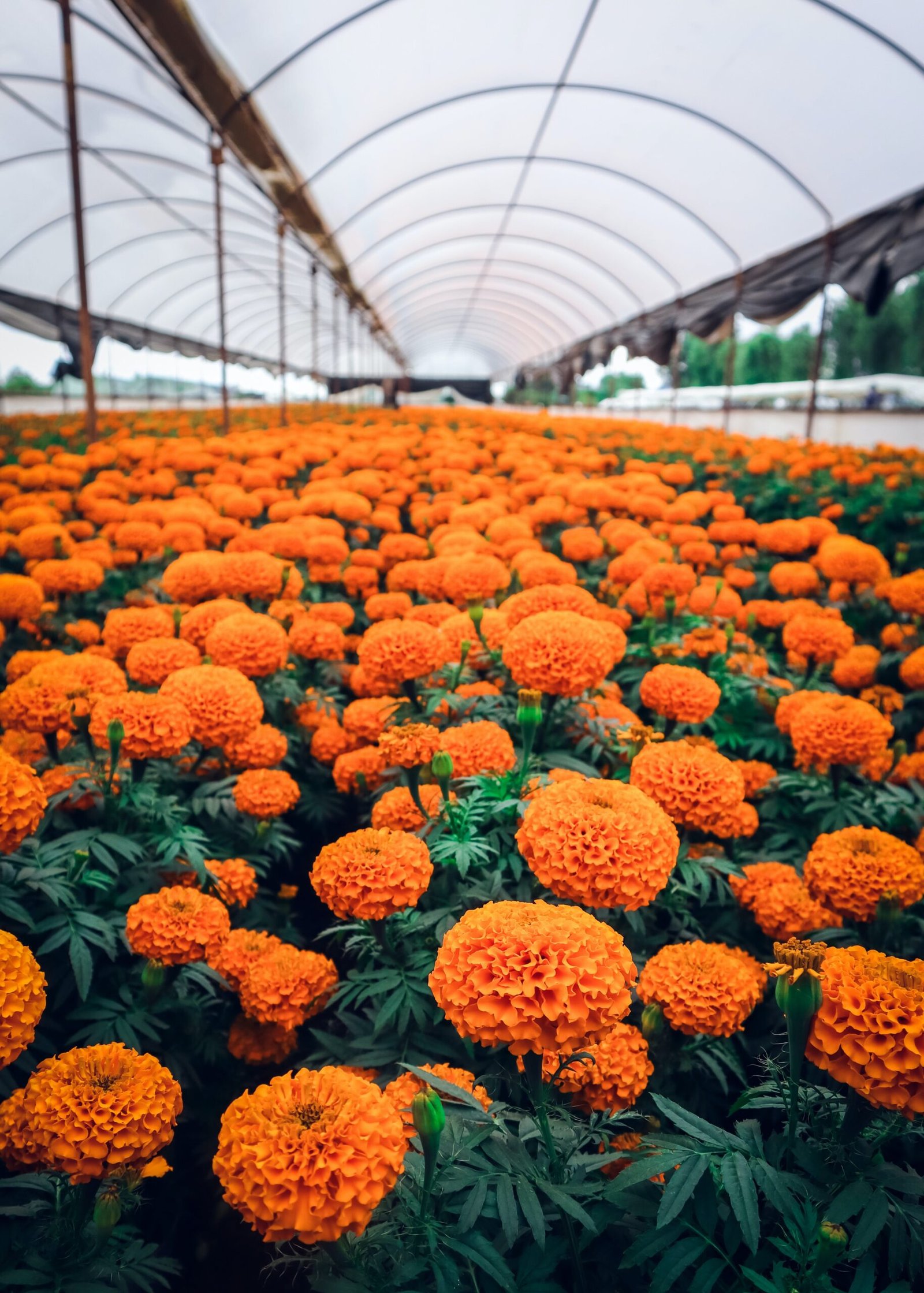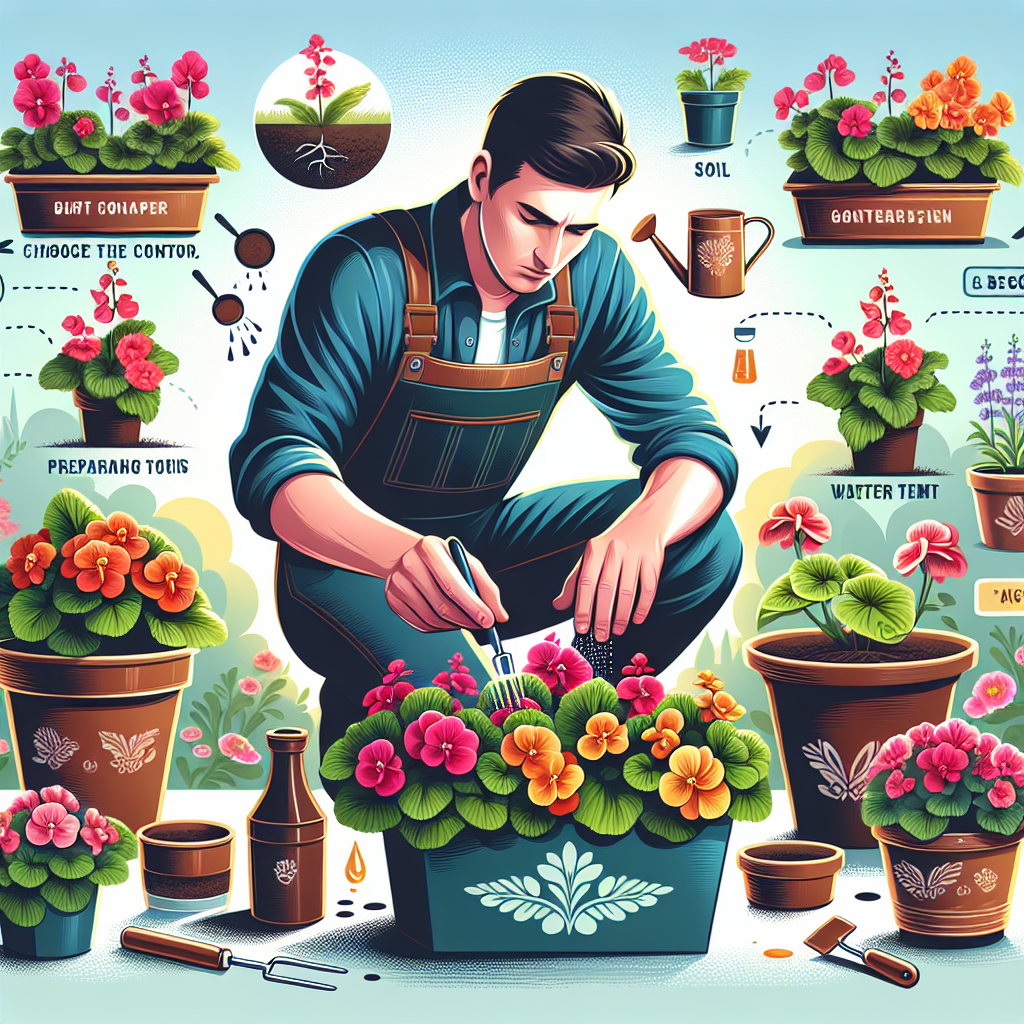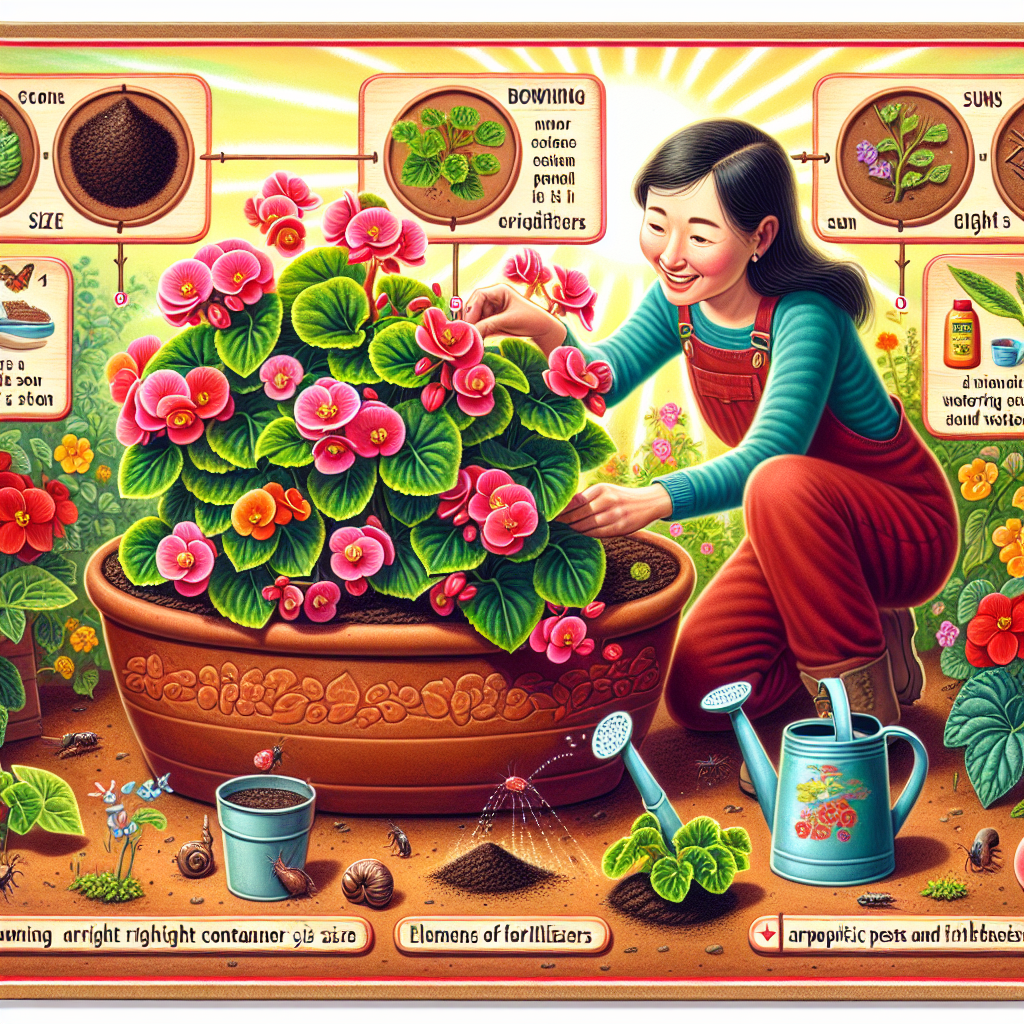
Are you interested in trying out container gardening with begonias but not sure where to start? Look no further! This beginner’s guide is here to help you navigate the world of container gardening, specifically focusing on the beautiful and versatile begonia plants. Whether you have limited outdoor space, want to add some greenery to your patio, or simply love the idea of nurturing your own plants, container gardening with begonias is a perfect option. In this article, we will cover everything from selecting the right containers and soil to watering and caring for your begonias, providing you with all the essentials to get started on your container gardening journey.

Choosing the Right Container
Size
When choosing a container for your begonias, consider the size of the plant and its root system. Begonias have varying growth habits, so it’s crucial to select a container that provides enough space for the plant to grow and thrive. If you plan to have multiple begonias in one container, make sure it is large enough to accommodate them without overcrowding.
Material
Containers for begonias come in various materials, each with its own pros and cons. Common options include clay, plastic, and wood. Clay pots allow for better airflow and drainage but can dry out quickly. Plastic containers are lightweight and retain moisture well, but they may not provide as much breathability. Wooden containers offer a natural and appealing look, but they can deteriorate over time.
Drainage
Proper drainage is crucial for begonias, as they dislike sitting in water-soaked soil. Look for containers that have drainage holes at the bottom to allow excess water to escape. If your chosen container doesn’t have drainage holes, you can drill some yourself. Additionally, consider placing a layer of small rocks or gravel at the bottom of the container to further enhance drainage.
Aesthetics
While functionality is essential, don’t forget about the aesthetics of your container. Choose a container that complements your personal style and the surroundings where you plan to display the begonias. Consider factors such as color, texture, and shape to create a visually pleasing arrangement that enhances the overall ambiance of your space.
Selecting the Right Begonias
Types of Begonias
There is a wide variety of begonia species to choose from, each with its own unique characteristics. Some popular types include tuberous begonias, fibrous begonias, rex begonias, and angel wing begonias. Research and familiarize yourself with the different types to determine which ones align with your preferences and the growing conditions in your area.
Light and Temperature Requirements
Begonias have varying light and temperature preferences, so it’s essential to choose ones that suit your specific growing conditions. Some begonias thrive in bright, indirect light, while others can tolerate more shade. Similarly, temperature requirements can range from warm to cool. Consider the location where you plan to keep your container begonias and choose varieties that are compatible with those conditions.
Soil and Fertilizer Needs
Begonias prefer well-draining soil that retains moisture but doesn’t become overly waterlogged. Opt for a high-quality potting mix specifically formulated for begonias or create a blend of equal parts peat moss, perlite, and compost. Additionally, begonias benefit from regular fertilization. Look for a balanced, water-soluble fertilizer and follow the manufacturer’s instructions for application rates and frequencies.
Propagating Begonias
If you’re interested in expanding your begonia collection or simply want to share your plants with others, you can propagate begonias through various methods. Common propagation techniques include stem cuttings, leaf cuttings, and division of tubers or rhizomes. Each method has its own requirements and steps, so be sure to research and follow proper guidelines to increase your chances of success.

Preparing the Container
Cleaning and Disinfecting
Before planting your begonias, it’s essential to clean and disinfect the container to prevent the spread of diseases or pests. Wash the container with warm, soapy water, and scrub away any dirt or debris. Then, rinse thoroughly and disinfect the container by soaking it in a solution of one part bleach to nine parts water for about 10 minutes. Rinse again with clean water to remove any remaining bleach residue.
Adding Drainage Holes
If your chosen container doesn’t have drainage holes, it’s crucial to add them to ensure proper drainage for the begonias. Use a drill with a bit suitable for the container’s material and carefully create several small holes at the bottom. Be cautious not to crack or break the container during this process. Once the holes are added, you can proceed with the planting steps.
Choosing the Right Soil Mix
Selecting the right soil mix is vital for the health and growth of your begonias. As previously mentioned, begonias prefer well-draining soil. Choose a potting mix specifically formulated for begonias or create your own blend using equal parts peat moss, perlite, and compost. Avoid using gardening soil from your yard, as it may be too dense and lacking in essential nutrients.
Filling the Container
When filling the container with soil, be sure not to pack it too tightly. Fill the container about two-thirds full, leaving enough space to accommodate the roots and provide room for future growth. Gently tamp down the soil to remove any air pockets without compacting it excessively. Leave approximately an inch or two of space between the top of the soil and the rim of the container for easier watering.
Planting and Arranging Begonias
Spacing
Proper spacing is crucial when planting begonias in a container to allow each plant enough room to grow and avoid overcrowding. Refer to the specific instructions for each begonia variety, as spacing requirements can vary. As a general guideline, aim to maintain a distance of at least six to twelve inches between each begonia plant.
Creative Combinations
Creating visually appealing combinations of begonias in a container adds interest and enhances the overall beauty of your garden display. Consider combining begonias with other flowering plants or foliage plants that complement their colors, shapes, and growth habits. Pay attention to the varying heights and growth rates of the plants you select for a balanced and harmonious arrangement.
Arranging Begonias
When arranging begonias in a container, think about the overall composition and balance. Place taller varieties towards the back or center of the container and shorter ones towards the front or edges. Take into account their growth habits and ensure each plant has enough space to spread out naturally. Experiment with different arrangements and adjust them until you achieve the desired visual effect.
Planting Depth
Proper planting depth is essential for begonias to establish themselves and grow successfully. As a general rule, the top of the begonia tuber or rhizome should be planted just slightly below the soil surface. If you’re planting begonias from seedlings or cuttings, ensure that the soil level is even with the base of the stem or slightly above it. Be cautious not to bury the begonias too deeply, as this can inhibit their growth.

Watering and Fertilizing
Watering Schedule
Establishing a regular watering schedule is crucial for maintaining the health and vitality of your container begonias. Begonias prefer to be kept evenly moist but not overly saturated. As a general guideline, check the moisture level of the soil with your fingers and water when the top inch feels dry. Be mindful not to let the soil dry out completely or become waterlogged, as both extremes can harm the begonias.
Watering Techniques
When watering your begonias, aim to water the soil directly rather than wetting the leaves or flowers excessively. Water gently and evenly to ensure thorough penetration without creating excessive runoff. Using a watering can with a narrow spout or a drip irrigation system can help control the flow and direct water to the root zone. Avoid overwatering, as it can lead to root rot or other moisture-related issues.
Fertilizer Application
Begonias benefit from regular fertilization to support their growth and promote abundant flowering. Apply a balanced, water-soluble fertilizer according to the manufacturer’s instructions. Generally, fertilize container begonias every two to four weeks during the growing season. Start fertilizing when the plants are actively growing and reduce or discontinue fertilization during their dormant or resting period.
Organic Fertilizer Options
If you prefer to use organic fertilizers, there are several options available for feeding your container begonias. Organic fertilizers derived from sources such as compost, fish emulsion, or seaweed extract can provide the necessary nutrients in a more natural and environmentally friendly way. Follow the product instructions for proper application rates, and monitor your plants’ response to determine any necessary adjustments.
Providing Adequate Light
Understanding Light Needs
Proper light exposure is crucial for begonias to grow and thrive. While light requirements can vary among begonia species, most begonias prefer bright, indirect light. They generally do not tolerate full sun, as it can scorch their leaves. However, some begonias, such as certain dragon-wing begonias, can tolerate more direct sunlight. Understand the specific light needs of your begonias and provide them with the appropriate lighting conditions.
Placement Tips
When deciding where to place your container begonias, consider their light requirements and the lighting conditions available in your space. Identify areas that receive bright, indirect light throughout the day and avoid locations with intense, direct sunlight. East and west-facing windowsills or shaded areas on the patio or porch can provide suitable light levels. If necessary, use sheer curtains or blinds to filter and diffuse the light.
Supplementing Natural Light
If your begonias aren’t receiving adequate natural light, you can supplement it with artificial lighting. LED grow lights or fluorescent lights provide a convenient solution for indoor or low-light areas. Place the lights close enough to the plants to ensure sufficient intensity and duration of light exposure. Monitor the plants closely and adjust the lighting setup accordingly to ensure they receive the optimal light levels.

Controlling Pests and Diseases
Common Pests
Like any garden plants, begonias can be susceptible to pest infestations. Common pests that may affect begonias include aphids, spider mites, mealybugs, and snails. Keep an eye out for any signs of insect damage, such as distorted leaves, webs, or visible pests. Regularly inspect your begonias, and take immediate action at the first sign of infestation to prevent the pests from spreading and causing further harm.
Preventive Measures
Taking preventive measures can significantly reduce the risk of pest infestations on your container begonias. Regularly inspect your plants for any signs of pests or diseases and promptly remove any infested or diseased foliage. Avoid overwatering or allowing excess moisture to accumulate, as wet conditions can attract pests. Additionally, regularly clean your containers, tools, and gardening equipment to minimize the chance of pests hitchhiking.
Natural Pest Control Methods
If you prefer to use natural methods for pest control, several options are available for managing common begonia pests. For example, you can use insecticidal soaps or neem oil, which are effective against soft-bodied insects like aphids and spider mites. Additionally, introducing beneficial insects such as ladybugs or lacewings can help keep pest populations in check. Research natural pest control methods specific to the pests you’re dealing with for more targeted solutions.
Identifying and Treating Diseases
Begonias can also be affected by various diseases, including powdery mildew, botrytis blight, and root rot. To prevent disease, ensure proper air circulation and avoid overhead watering. If you notice any signs of disease, such as discolored or distorted foliage, black spots, or wilting, identify the specific disease and take appropriate action. Treatments may include removing affected foliage, improving cultural conditions, or using fungicides as a last resort.
Pruning and Deadheading
Pruning for Size and Shape
Regular pruning helps maintain the size and shape of your container begonias, promotes branching, and allows for better airflow and light penetration. Use clean and sharp pruning shears to make clean cuts just above a leaf node or bud. Trim back any overgrown or straggly stems, taking care not to remove too much foliage at once. Additionally, remove any yellow or damaged leaves to keep the plants looking tidy and healthy.
Deadheading to Promote Blooming
Deadheading, or removing spent flowers, is an essential practice for promoting continuous blooming in your begonias. As flowers fade, pinch or cut the stem just above a leaf node or bud. This encourages the plant to redirect its energy towards producing new flowers instead of setting seeds. Regular deadheading also helps maintain a neat and tidy appearance and prevents the development of seed pods.
Tools and Techniques
Invest in a good pair of pruning shears specifically designed for gardening tasks. Ensure they are sharp and clean before each use to minimize the risk of spreading diseases. Take your time when pruning, making deliberate cuts to avoid damaging healthy parts of the plant. Sterilize your tools between plants, especially if you suspect any disease or pest issues, to prevent cross-contamination.

Overwintering Begonias
Preparing for Winter
Begonias are generally tender perennials, meaning they are not cold hardy and can be damaged or killed by freezing temperatures. Before winter arrives, assess the specific hardiness zone of your begonias to determine if they can survive outdoors or require protection. If they need protection, plan to overwinter them indoors or in a sheltered location where temperatures stay above freezing.
Storage Options
When overwintering container begonias indoors, you have several storage options. One common method is to dig up the begonias from the container and store the tubers or rhizomes. Remove any remaining foliage, gently shake off excess soil, and allow the tubers to dry for a few days. Then, place them in a container filled with peat moss or vermiculite, ensuring they are stored in a cool, dark, and dry location.
Winter Care Tips
During the winter months, it’s crucial to provide the right care for your overwintered begonias. Keep the storage containers in a location with a consistent temperature between 45-55°F (7-13°C). Check the moisture level periodically, ensuring the storage medium remains slightly moist but not overly wet. Avoid exposing the stored begonias to direct sunlight or temperature fluctuations, as this can disrupt their dormancy.
Replanting in Spring
When spring arrives and the risk of frost has passed, it’s time to replant your overwintered begonias. Remove the storage containers from their resting location, and gently separate any tubers or rhizomes that have naturally multiplied. Inspect the begonias for any signs of damage or disease, and discard any compromised parts. Replant the healthy begonias in fresh, well-draining soil, and provide them with the necessary care and maintenance throughout the growing season.
Showcasing Container Begonias
Choosing the Right Display Location
When displaying your container begonias, select a location that best showcases their beauty while providing suitable growing conditions. Consider factors such as lighting, temperature, and aesthetics. Choose areas that receive the right amount of sunlight or shade based on your begonias’ specific requirements. Additionally, take into account the surrounding environment, such as nearby plants, structures, or natural features, to create a cohesive and visually appealing display.
Complementing Container Designs
Container begonias can enhance the visual appeal of any outdoor or indoor space. When selecting containers, consider how they will complement the overall design theme or style of your garden or living area. Opt for containers that harmonize with the color scheme and architectural features of your space. Additionally, choose containers with unique textures, shapes, or patterns to add visual interest and intrigue.
Adding Accents and Decor
To further elevate the display of your container begonias, consider adding accents and decor elements that enhance their beauty. Arrange complementary plants, such as trailing vines or colorful annuals, around the begonias to create a layered and dynamic look. Incorporate decorative elements like garden stakes, trellises, or statues to add focal points and create a sense of artistry. Experiment with different combinations to discover what appeals most to your personal style and preferences.
Maintenance and Year-Round Appeal
Maintaining the beauty and appeal of your container begonias requires regular care and attention. Water them according to their specific needs, avoiding overwatering or underwatering. Monitor for any signs of pests or diseases and take immediate action if necessary. Regularly prune, deadhead, and fertilize to promote healthy growth and continuous blooming. Additionally, consider seasonal adjustments, such as changing container arrangements or selecting different plant combinations, to keep the display fresh and visually captivating throughout the year.





